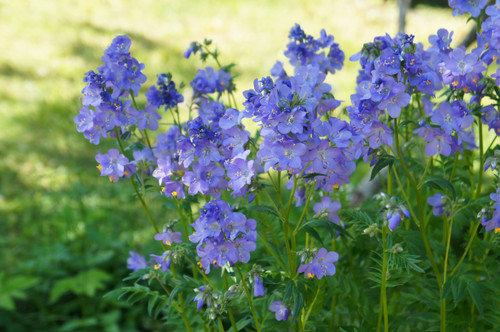Jacob's Ladder, Polemonium
Jacob's ladder (Polemonium is a perennial plant grows to a height of 30-60cm (12-24 inches) and produces fern-like leaves that are arranged in a ladder-like formation along the stem. The flowers are blue, violet or white and bloom in late spring through early summer.
Jacob's ladder prefers partial shade to full shade and moist, well-drained soil. It can be grown in USDA hardiness zones 3-8. The plant is often used in woodland gardens, shade gardens, and cottage gardens. It can also be used as a ground cover or planted in containers.
How to care for Jacob's ladder plant:
- Light: Jacob's ladder prefers partial shade to full shade. Too much direct sunlight can burn or harm the leaves.
- Soil: The plant prefers moist, well-drained soil that is rich in organic matter. It does not do well in dry soil.
- Water: Water the plant regularly to keep the soil moist but not waterlogged. During hot and dry weather, the plant may need more frequent watering.
- Fertilizer: You can fertilize Jacob's ladder once or twice a year with a balanced fertilizer. Apply the fertilizer in the spring and/or fall.
- Pruning: After the plant has finished flowering, you can prune back the stems to encourage new sprouts.
- Propagation: You can propagate Jacob's ladder by dividing the plant in the spring or fall. Dig up the plant and separate the roots into smaller sections, each with several stems and roots.
- Pests and diseases: Jacob's ladder is generally resistant to pests and diseases, but you should keep an eye out for slugs and snails, which can damage the leaves. If you notice signs of disease, such as brown or black spots on the leaves, remove the affected leaves and dispose of them.
How to care for the Jacob's ladder plant:
- Choose a planting location: Jacob's ladder prefers partial shade to full shade and moist, well-drained soil that is rich in organic matter. Choose a location that meets these requirements.
- Prepare the ground: Shovel a hole that is about twice as big as the plant's root ball. Mix in potting soil if it is not rich in nutrients.
- Plant the Jacob's ladder: Carefully remove the plant from its container and loosen any trapped roots. Put the roots in the hole and backfill with soil, making sure the top of the root is even with the surrounding soil. Water the plant thoroughly.
- Mulch: Spread a layer of organic mulch, such as shredded leaves or bark, around the base of the plant. This will help keep the moisture f the plant and prevent weeds.
- Watering and care: Water the plant regularly to keep the soil moist but not waterlogged.
Jacob's ladder for sale online at Perennial Nursery.
Jacob's ladder can also be propagated by dividing the plant in the spring or fall. Dig up the plant and separate the roots into smaller sections, each with several stems and roots, and plant these in a new location following the same steps above.
FAQ
1. Where is the best place to plant Jacob's Ladder?
A. Jacob's Ladder grows well in a moderately shady site with loose, rich soil.
2. Does Jacob's Ladder plant spread?
A. Jacob's Ladder doesn't typically spread aggressively like some ground covers or invasive plants, it can slowly expand through self-seeding. The plant generally forms clumps, and over time, new plants may emerge from seeds dropped by the parent plant. However, it's not considered highly invasive.
-
Jacob's Ladder
These plants are so neat. I like them very much and am wanting to plant more.




